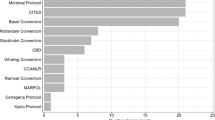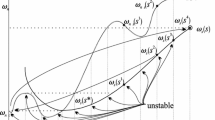Abstract
We examine the economic factors that lead to the formation of multilateral environmental agreements, focusing on the likelihood a pair of countries enters into an agreement as well as the number of agreements they share using a near universe of agreements. Two countries are more likely to have an agreement and have more of them if they are economically larger and of similar economic size, closer in distance, have a preferential trade agreement, and trade more. Results are strongest for agreements involving a small number of countries, consistent with a hypothesis that agreements are formed to manage common pool resources.









Similar content being viewed by others
Notes
Technically speaking, there is an exception to this principle given that a number of members of the World Trade Organization, which one can consider to be a large trade agreement, have separate agreements governing trade issues pertaining to a subset of WTO members. The North American Free Trade Agreement is one example of such an agreement. It should be noted that most papers examining various aspects of trade agreements tend to focus on the smaller trade agreements and ignore the WTO given that most countries are members of the WTO. Unlike environmental agreements, Canada, the USA, and Mexico share only one trade agreement, NAFTA. In the case they both sign the same trade agreement with additional countries, the new agreement would replace NAFTA, as would have been the case with the now abandoned (by the USA) Trans Pacific Partnership agreement. The only plausible exception of this is the European Union if one treats EU members separately, in which case it may appear that EU members may be parties to multiple trade agreements amongst each other whenever the EU itself enters into trade agreements with other countries. However, whatever concessions the EU may provide in such agreements have no effect on the trade between EU members which is free of any policy intervention due to the nature of the EU itself.
The source for this data is the Transboundary Waters Assessment Programme, http://www.getwap.org.
For example, when signing the North American Free Trade Agreement, Canada, Mexico, and the USA also signed a side agreement, the North American Agreement on Environmental Cooperation which stipulated that each country must enforce its environmental laws and created a dispute settlement mechanism for enforcement purposes.
Analogous results for other specifications are available on request from authors.
In unreported results, we estimated our specifications with contemporaneous values but with a balanced panel of countries that are observed in every single year. This also resulted in negatively estimated coefficients for trade agreements. We then split the agreement dummy variable to identify two separate types of trade agreements: one-way agreements, largely Generalized System of Preferences granted by developed countries to developing countries, and reciprocal, two-way agreements in which both parties provide the same concessions and equal market access. Those results reveal that the negative effect of the single trade agreement variable is driven by one-way agreements. One-way trade preferences are rarely granted by countries in close proximity to each other. In other words, they are rarely granted by countries that share common pool resources and are less likely to engage in environmental agreements given the distance that separates them. The estimated coefficient on reciprocal, two-way agreements is always positive and significant. These results are available on request.
References
Asheim, G. B., Froyn, C. B., Hovi, J., & Menz, F. C. (2006). Regional versus global cooperation for climate control. Journal of Environmental Economics and Management, 51, 93–109.
Baghdadi, L., Martinez-Zarzoso, I., & Zitouna, H. (2013). Are RTA agreements with environmental provisions reducing emissions? Journal of International Economics,90(2), 378–390.
Baier, S. L., & Bergstrand, J. H. (2004). Economic determinants of free trade agreements. Journal of International Economics,64(1), 29–63.
Baier, S. L., & Bergstrand, J. H. (2007). Do free trade agreements actually increase members’ international trade. Journal of International Economics,71(1), 72–95.
Baldwin, R., & Jaimovich, D. (2012). Are free trade agreements contagious? Journal of International Economics,88(1), 1–16.
Barrett, S. (1994). Self-enforcing international environmental agreements. Oxford Economic Papers,46, 878–894.
Barrett, S. (1997). The strategy of trade sanctions in international environmental agreements. Resource and Energy Economics,19(4), 345–361.
Barrett, S. (2001). International cooperation for sale. European Economic Review,45(10), 1835–1850.
Barrett, S. (2002). Consensus treaties. Journal of Institutional and Theoretical Economics,158(4), 529–547.
Barrett, S. (2005). The theory of international environmental agreements. In K. G. Mäler & J. R. Vincent (Eds.), Handbook of environmental economics (Vol. 3, pp. 1457–1516). London: Elsevier.
Bergstrand, J. H., Egger, P. H., & Larch, M. (2016). Economic determinants of the timing of preferential trade agreement formations and enlargements. Economic Inquiry,54(1), 315–341.
Bernauer, T., Kalbhenn, A., Koubi, V., & Spilker, G. (2010). A comparison of international and domestic sources of global governance dynamics. British Journal of Political Science,40(3), 509–538.
Beron, K. J., Murdoch, J. C., & Vijverberg, Wim P. M. (2003). Why cooperate? Public good, economic power, and the Montreal protocol. The Review of Economics and Statistics,85(2), 286–297.
Carraro, C., & Siniscalco, D. (1993). Strategies for the international protection of the environment. Journal of Public Economics,52(3), 309–328.
Carraro, C., & Siniscalco, D. (1998). International institutions and environmental policy: International environmental agreements: Incentives and political economy. European Economic Review,42(3–5), 561–572.
Chen, M., & Joshi, S. (2010). Third-country effects on the formation of free trade agreements. Journal of International Economics,82(2), 238–248.
Chen, C., & Zeckhauser, R. (2018). Collective action in an asymmetric world. Journal of Public Economics,158(C), 103–112.
Davies, R. B., & Naughton, H. T. (2014). Cooperation in environmental policy: A spatial approach. International Tax and Public Finance,21(5), 923–954.
Egger, P. H., Jessberger, C., & Larch, M. (2011). Trade and investment liberalization as determinants of multilateral environmental agreement membership. International Tax and Public Finance,18(6), 605–633.
Egger, P. H., Jessberger, C., & Larch, M. (2013). Impacts of trade and the environment on clustered multilateral environmental agreements. The World Economy,36(3), 331–348.
Egger, P. H., & Larch, M. (2008). Interdependent preferential trade agreement memberships: An empirical analysis. Journal of International Economics,76(2), 384–399.
Eichner, T., & Pethig, R. (2013). Self-enforcing environmental agreements and international trade. Journal of Public Economics,102(1), 37–50.
Eichner, T., & Pethig, R. (2015). Is trade liberalization conducive to the formation of climate conditions? International Tax and Public Finance,22(6), 932–955.
Eichner, T., & Pethig, R. (2018). Global environmental agreements and international trade: Asymmetry of countries matters. Strategic Behavior and the Environment,7(3–4), 281–316.
Finus, M. (2008). Game theoretic research on the design of international environmental agreements: Insights, critical remarks, and future challenges. International Review of Environmental and Resource Economics,2, 29–67.
Finus, M., & Al Khourdajie, A. (2018). Strategic environmental policy, international trade and self-enforcing agreements: The role of consumers’ taste for variety. Strategic Behavior and the Environment,7(3–4), 317–350.
Finus, M., Altamirano-Cabrera, J.-C., & Van Ierland, E. C. (2005). The effect of membership rules and voting schemes on the success of international climate agreements. Public Choice,125(1–2), 95–127.
Fredriksson, P. G., & Gaston, N. (2000). Ratification of the 1992 climate change convention: What determines legislative delay? Public Choice,104(3–4), 345–368.
Gelves, A., & McGinty, M. (2016). International environmental agreements with consistent conjectures. Journal of Environmental Economics and Management,78(C), 67–84.
Hoel, M. (1992). International environment conventions: The case of uniform reductions of emissions. Environmental and Resource Economics,2(2), 141–159.
Hoel, M., & Schneider, K. (1997). Incentives to participate in an international environmental agreement. Environmental and Resource Economics,9(2), 153–170.
Hovi, J., Ward, H., & Grundig, F. (2015). Hope or despair? Formal models of climate cooperation. Environmental and Resource Economics,62(4), 665–688.
Kuhn, T., Pestow, R., & Zenker, A. (2019). Building climate coalitions on preferential free trade agreements. Environmental and Resource Economics,74(2), 539–569.
Libecap, G. D. (2014). Addressing global environmental externalities: Transaction costs considerations. Journal of Economic Literature,52(2), 424–479.
Limão, N. (2005). Trade policy, cross-border externalities and lobbies: Do linked agreements enforce more cooperative outcomes? Journal of International Economics, 67(1), 175–199.
Mason, C. F., Polasky, S., & Tarui, M. (2017). Cooperation on climate-change mitigation. European Economic Review,99, 43–55.
Millimet, D. L., & Roy, J. (2015). Multilateral environmental agreements and the WTO. Economics Letters,134, 20–23.
Mitchell, R. B. (2002–2015). International environmental agreements database project. http://iea.uoregon.edu/.
Mitchell, R. B. (2003). International environmental agreements: A survey of their features, formation, and effects. Annual Review of Environment and Resources,28, 429–461.
Murdoch, J. C., Sandler, T., & Vijverberg, Wim P. M. (2003). The participation decision versus the level of participation in an environmental treaty: A spatial probit analysis. Journal of Public Economics,87(2), 337–362.
Neumayer, E. (2002). Does trade openness promote multilateral environmental cooperation? The World Economy,25(6), 815–832.
Nordhaus, W. (2015). Climate clubs: Overcoming freeriding in international climate policy. American Economic Review,105(4), 1339–1370.
Rubio, S. J., & Ulph, A. (2007). An infinite-horizon model of dynamic membership of international environmental agreements. Journal of Environmental Economics and Management,54(3), 296–310.
Sandler, T. (1997). Global challenges: An approach to environmental, political, and economic problems. Cambridge: Cambridge University Press.
Sandler, T. (2017). Environmental cooperation: Contrasting international environmental agreements. Oxford Economic Papers,69(2), 345–364.
Silva, E. C. D. (2017). Self-enforcing agreements under unequal nationally determined contributions. International Tax and Public Finance,24(4), 705–729.
Acknowledgements
We are grateful to Ron Davies, the editor of this journal, two anonymous referees, Juan Moreno-Cruz, Dan Matisoff, and seminar participants at Appalachian State University and Hunan University for valuable comments and suggestions.
Author information
Authors and Affiliations
Corresponding author
Additional information
Publisher's Note
Springer Nature remains neutral with regard to jurisdictional claims in published maps and institutional affiliations.
Rights and permissions
About this article
Cite this article
Besedeš, T., Johnson, E.P. & Tian, X. Economic determinants of multilateral environmental agreements. Int Tax Public Finance 27, 832–864 (2020). https://doi.org/10.1007/s10797-019-09588-z
Published:
Issue Date:
DOI: https://doi.org/10.1007/s10797-019-09588-z




